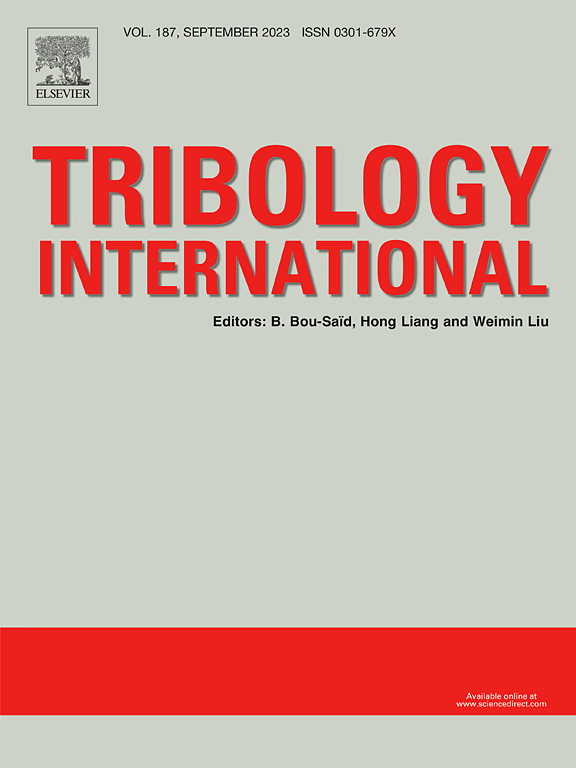3D TiO2 foam-supported Ni–B-La films for superior anti-corrosive and tribo-mechanical performances
IF 6.1
1区 工程技术
Q1 ENGINEERING, MECHANICAL
引用次数: 0
Abstract
Herein the self-lubricating Ni-B-La films were deposited onto porous surfaces of Ti substrate to modify its surface defects like low hardness, poor wear resistance, etc. The anodized titanium oxides (ATO) surfaces within 3D foam-like nanoporous textures were created for pinning growth by low-temperature electroless Ni-B nanocrystals to increase the interfacial strength. Specifically, the impact of LaCl3 addition and aging temperatures on structural and tribo-mechanical characteristics of Ni-B-La films were assessed. The results validated that, instead of the cauliflower-like cellular, the inclusion of La3+ in plating bath was favorable for a flat surface within microcrystal textures. Through aged at 350 °C, it depicted the highest microhardness of 1163.6HV0.1 and the lowest coefficients of friction (COF) value of ∼0.12 for Ni-B-La (3 g/L LaCl3) samples. Additionally, the wear rate of Ni-B-La films was lower than 1.76 × 10−3 mm3·N−1·m−1, reducing by 667.1 % and 133.0 % than those of Ti substrate and Ni-B alloys. Both the precipitations of hard NixB particles and La-rich oxides resulted in the self-lubricating surfaces. Our work offers exceptional prospects for La-doped Ni-B films towards porous surfaces, allowing to satisfy the surface functional of Ti-based engineering applications under dry friction conditions.
三维 TiO2 泡沫支撑的 Ni-B-La 薄膜具有卓越的抗腐蚀和三机械性能
本文将自润滑 Ni-B-La 薄膜沉积到钛基材的多孔表面,以改变其硬度低、耐磨性差等表面缺陷。在三维泡沫状纳米多孔纹理中的阳极氧化钛(ATO)表面,通过低温无电解 Ni-B 纳米晶体的针刺生长来增加界面强度。具体而言,评估了 LaCl3 添加量和老化温度对 Ni-B-La 薄膜的结构和三力学特性的影响。结果证实,在电镀液中加入 La3+ 有利于在微晶纹理内形成平坦的表面,而不是菜花状的蜂窝。经过 350 °C 老化,Ni-B-La(3 g/L LaCl3)样品的显微硬度最高,达到 1163.6HV0.1,摩擦系数(COF)最低,为 0.12。此外,Ni-B-La 薄膜的磨损率低于 1.76 × 10-3 mm3-N-1-m-1,比钛基材和 Ni-B 合金的磨损率分别降低了 667.1 % 和 133.0 %。坚硬的 NixB 颗粒和富含 La 的氧化物的沉淀都产生了自润滑表面。我们的研究为掺 La 的 Ni-B 薄膜走向多孔表面提供了广阔的前景,从而满足了干摩擦条件下基于 Ti 的工程应用的表面功能要求。
本文章由计算机程序翻译,如有差异,请以英文原文为准。
求助全文
约1分钟内获得全文
求助全文
来源期刊

Tribology International
工程技术-工程:机械
CiteScore
10.10
自引率
16.10%
发文量
627
审稿时长
35 days
期刊介绍:
Tribology is the science of rubbing surfaces and contributes to every facet of our everyday life, from live cell friction to engine lubrication and seismology. As such tribology is truly multidisciplinary and this extraordinary breadth of scientific interest is reflected in the scope of Tribology International.
Tribology International seeks to publish original research papers of the highest scientific quality to provide an archival resource for scientists from all backgrounds. Written contributions are invited reporting experimental and modelling studies both in established areas of tribology and emerging fields. Scientific topics include the physics or chemistry of tribo-surfaces, bio-tribology, surface engineering and materials, contact mechanics, nano-tribology, lubricants and hydrodynamic lubrication.
 求助内容:
求助内容: 应助结果提醒方式:
应助结果提醒方式:


